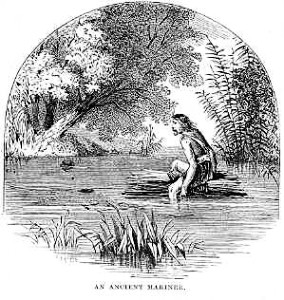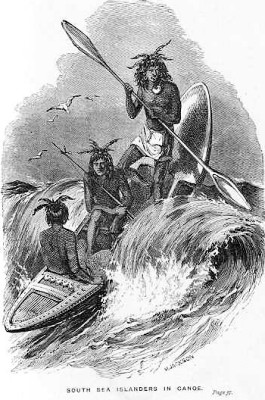AMUSEMENTS:
DIVING AND SWIMMING EXTRAORDINARY.
It is a curious fact that some of the games
played by the little naked savage children of the
South Sea Islands are very similar to our own.
A traveller who had sauntered to a part of the
sea-beach of one of the islands to watch the
children at play, tells us that one band was
busily employed in playing blind-man's-buff".
Another group were walking on stilts that raised
them three feet or so from the ground; while
others were engaged in flying kites. These kites
were of all shapes and sizes and made of thin
Page 208
cloth of native manufacture, and were raised to a
great height by means of twine, made of the
fibrous husk of the cocoa-nut.
But the amusement which these people take the
greatest delight in old as well as young, is
swimming and diving in the sea ; and the
expertness exhibited by them is most
extraordinary.
They have two principal games in the water ; one
of which consists in diving off a sort of stage,
erected close to deep water, and chasing each
other in the sea.
Some of them go down to extraordinary depths;
others skim along on the surface or roll over like
porpoises, or diving under each other, come up
unexpectedly and pull each other down by a leg or
an arm.
They never seem to tire of this sport, and from
the great heat of the water in the South Seas,
they can remain in it for hours at a time without
feeling chilled.
Even infants just able to walk waddle down to the
beach, throw themselves into the water, and strike
boldly out to sea like ducklings.
Mothers, too, jump in with their little infants at
their breasts, and gambol with there in the water,
as mothers in this civilized land sport with their
little ones on grassy lawns.
One would think that swimming miles out to sea,
and diving fathoms down into the deep, to disport
among the lovely coral groves at the bottom, with,
now and then, the chance of being bitten in two by
a shark, would be excitement enough for these
savages.
By no means !
They must add to these amusements that riotous,
boisterous, and somewhat dangerous one called
"winning (sic)
in the surf," which is practised as follows :-
On the shores of those islands of the Pacific that
are not guarded by a breakwater of coral, there
falls, with slow
Page 209
regular majestic thunder, a mighty billow which never
goes down, even in the calmest weather.
It is not the result of wind, it is the
termination of that long rolling swell that moves
across the wide sea in a calm, the ocean's breathing,
as it were, while asleep.
In storms, of course, this billow mounts in size, and
rages along intermixed with a thousand superficial
waves, and when it reaches the shore it bursts into
foam upon the rocks with a savage fury that bids fair
to demolish the solid earth itself.
But even in the deadest calm the billow rises with its
great broad glossy back glittering with the sunbeams,
until it approaches to within a mile of the shore.
Then it becomes like an emerald wall, its crest
overlaps, ripples, breaks, and, with a deep solemn
roar it rushes on, a world of snowy water to engulf
the beach.
It is on this crested wave that the natives ride.
They assemble in hundreds on the beach, each with a
short fiat board in his hand.
Just after a billow has broken they rush into the surf
with loud yells, and are carried off by the seething
foam of the receding wave.
For some time the swimmers continue to strike out to
sea, breasting over the swell like hundreds of black
seals.
There they all turn, and, watching an approaching
billow, mount on its white crest ; each laying his
breast on the short flat board above mentioned, they
come rolling towards the shore, careering on the
summit of the mighty wave, with a speed that seems to
threaten their total destruction, while the onlookers
shout and yell in an ecstasy of excitement and
delight.
Just as the monster wave is about to fling its bulky
length upon the shore, most of the swimmers slide back
into the trough behind it.
Others, slipping off their boards, seize them in their
hands, and
Page 210
plunging through the watery waste, swim out to repeat
the amusement, while a few come reckless on, amid the
churning foam and spray, to the shore.





